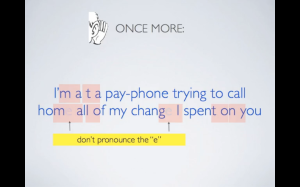One of the resources I developed for my course on English pronunciation in Iraq last summer was a cloze (fill-in-the-blank) worksheet based on the song “Happy” by Pharrell Williams. You can watch the music video from YouTube here:
The area of English pronunciation I was looking to target was connected speech–and specifically reductions. My goal was to aid students in their listening comprehension of reductions in natural speech. Especially for learners of English as a foreign language (or English as a lingua franca, ELF) setting, I believe this to be the more important goal, since ELF speakers typically won’t incorporate as many reductions into their speech as L1 English speakers, without any negative impact on comprehensibility. In any case, popular music is a great resource for training learners in understanding reductions, since songs tend to contain so many examples of these.
With this as a starting point, I could have chosen any number of songs as the basis for a listening task. The reason that I chose “Happy” in particular had to do with the broad appeal that the song has had in a variety of different countries, as evidenced by the proliferation of music video adaptations from across the globe. (See here for a version produced close to where I was teaching at the time, which my students pointed me to with great delight.) In part, I was simply looking for a music video that would be unobjectionable to a more conservative Middle Eastern student audience, and this fit the bill. It is also just a fun, foot-tapping song, which my current students here in Norway have responded to just as enthusiastically as my Iraqi students did. As for linguistic criteria, the song seemed like a good choice because the vocabulary it uses is relatively simple, allowing students to focus on the pronunciation features rather than on vocabulary learning.
To make the worksheet, I identified key words and phrases that evidence reduction. These became the gaps (blank lines) in my version of the song lyrics. I tried in particular to include phrases that might arise in natural conversation as well (e.g. I’m about to, want to, don’t). I also included one targets that, strictly speaking, is not an example of reduction but of connected speech more broadly (go to, with a flapped [D] in place of /t/), but the main focus is on reductions of words or phrases.
The activity has been well received by the students I have tried it with so far in Iraq and Norway. It has lent itself to discussion of the relative importance of understanding English reductions vs. using them in one’s own speech, characteristics of various spoken varieties of English (for example, dialect features evident in Pharrell’s pronunciation, such as “prolly” for probably), and sounds that arise as a result of reduction (e.g. glottal stop in can’t nothing), among other things.
You can download my worksheet here: Happy Cloze. I have not included a key, but you can find the full lyrics to the song on many websites, such as this one. Let me know how it goes if you try it with your students–or if you discover a mistake I should fix. Thanks!



